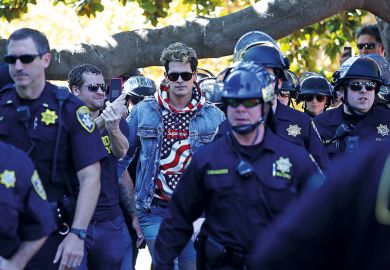The battered saddle displayed on a podium in the middle of the office of the president of California State University, Sacramento comes with a backstory. Its owner Robert Nelsen, the head of Sac State, says that it (possibly) used to belong to Wild West folk heroine Calamity Jane. For him, it serves as an ice-breaker – visitors wonder, understandably, “what the heck, why does someone have a saddle in their office?” – but also as an important reminder to himself about the point of education.
The university is part of the CSU system, which sits in the midpoint of the internationally admired public California Master Plan for Higher Education, between the University of California research institutions and the California Community Colleges System.
At Sac State, located in California’s state capital, 49 per cent of students come from families with annual earnings of $38,000 (£28,682) or less, said Dr Nelsen.
“I grew up in poverty on a ranch in Montana with no dreams of higher education or anything like that,” he told Times Higher Education. Being a “first generation” college student “makes a huge difference” in his approach to leading the university, he added.
Formerly president of the University of Texas-Pan American (since merged into the University of Texas Rio Grande Valley), where “every student I graduated lifted a whole family out of poverty”, he subsequently “chose [to join] Sac State [in 2015] because our graduation rates were so poor” and there was a job to be done.
The proportion of students graduating within four years was at 8 per cent, “which is abysmal”, Dr Nelsen said, but is now up to 12 per cent. “We’ll be at 16 per cent next year, 20 per cent the year after that.”
That has involved starting to remedy a shortage of classes and faculty, so it’s easier for students to earn the 15 course credits per semester that they need to get through in four years. Helping them to graduate as quickly as possible means less debt and a chance to start a full-time career earlier – a significant financial difference for students.
Dr Nelsen, who sits on the Greater Sacramento Economic Council alongside a number of chief executives, said that to attract more major corporations to the area – including, it is hoped, Amazon’s second headquarters – “one of the things we have to do is increase the proportion of people who have a bachelor’s degree”.
Explaining that the proportion of graduates in the general population of Sacramento is 19 per cent and 26 per cent in the wider region, he added: “We need to be closer to 50 per cent: the way Austin is, the way Spokane, Salt Lake, Seattle – those cities – are.”
Another priority for Sac State is the future of its students who arrived in the US under the Deferred Action for Childhood Arrivals, or DACA, policy, which gives temporary protection to undocumented migrants who entered the country as children. Donald Trump has chosen to end the scheme.
DACA students “don’t know what’s going to happen after 5 March [the federal programme’s official end date], don’t know if they’re going to have a job, they don’t know what their future is going to be”, said Dr Nelsen. “I’m tremendously concerned for those students.”
Is it possible to put a figure on how many DACA students the university has? “It’s possible, but I won’t,” he replied. “We deliberately don’t collect the information on the students. That puts them in jeopardy.”
Sac State is known for the diversity of its student body – including 29 per cent Latino, 28 per cent white, 20 per cent Asian American, 12 per cent “other” or multiracial and 6 per cent African American.
Dr Nelsen called this “one of the largest strengths of Sac State”. He added: “In diversity there is absolute strength. When we learn to talk to each other…accept each other…that we’re all humans with the same dreams and same hopes, we’re all much better people.”
As for the saddle, the backstory is that when Dr Nelsen was growing up on the ranch in Montana, his family “didn’t have enough money for two saddles, so I rode bareback”.
That was until a 93-year-old family friend stepped in. He had once worked as a bottle-washer and cook at a Wild West show where Calamity Jane was the sharpshooter, and she had gifted him the saddle for assisting her after she drunkenly rode naked through the camp. It was this prized possession that he passed on to Dr Nelsen.
So the saddle “reminds me what I began with – and that without an education, I would still be working on a ranch and doing hard labour” and that, for Sac State’s students, “education is going to lift them just like it lifted me”, Dr Nelsen said. His parents being Mormon led him on to degrees at the Mormon institution Brigham Young University, and he eventually became an English professor – which he described as “one of the most wonderful things that ever happened in my life”.
And there’s also a reminder with the saddle, he added, that “if it wasn’t for the kindness of others, we would never succeed”.
Register to continue
Why register?
- Registration is free and only takes a moment
- Once registered, you can read 3 articles a month
- Sign up for our newsletter
Subscribe
Or subscribe for unlimited access to:
- Unlimited access to news, views, insights & reviews
- Digital editions
- Digital access to THE’s university and college rankings analysis
Already registered or a current subscriber?








